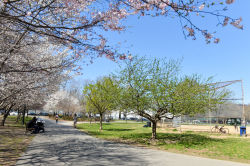McCarren Park
McCarren Pool
For outdoor pool details, including hours and rules, please visit our Free Outdoor Pools page.
What was here before?
Prior to the pool’s construction, the property was surrounded by a mix of light and heavy industry such as lumber and scrap metal yards. The vast local working-class population often lived in destitute conditions, and at the time the pool opened the neighborhood had one of the highest unemployment rates in the city.
How did this site become a pool?
The summer of 1936, deep in the Great Depression, broke local heat records. McCarren Pool was one of eleven immense outdoor public pools the Parks Department opened that summer. The heroically scaled pools project was financed by the Federal Works Progress Administration (WPA), as part of a massive effort to alleviate adverse health conditions and provide safe recreation in predominantly working-class communities.
The pools were not just huge but also examples of state-of-the-art engineering and fine design. Each pool had separate swimming, diving and wading areas, perimeter bleachers, and bathhouses whose locker rooms served as gyms during non-summer months. Led by architect Aymar Embury II and landscape architect Gilmore D. Clarke, the planning team produced a series of distinct complexes, each one sensitive to its site and topography. Massive filtration systems, heating units, and even underwater lighting provided a more controlled bathing experience than the often treacherous and polluted waterways in which the City’s masses had traditionally swum. The palette of pools building materials was mainly inexpensive brick, concrete and cast stone, but the styles ranged from Romanesque Revival to Art Deco.
Opened on July 31, 1936, McCarren Pool originally measured 330 by 165 feet and was designed to accommodate 6,800 bathers at a time. In the off-season the pool bottom was adapted for basketball and shuffleboard courts. Its bathhouse was the largest in the system, with an open vaulted entryway reminiscent of the Roman baths of Caracalla and the Karl Marx Hof housing complex in Vienna. Other notable features include an Art Moderne-styled entry kiosk and flagstaffs supported by bronze eagles.
The pool is the only WPA facility to close due to dereliction, from 1984 to 2012. In 2005-07, a series of experimental dance performances and concerts were held in the empty pool renewed interest in the facility. After it was designated an official New York City Landmark in 2007, it underwent an extensive renovation. The pool reopened in 2012, with a smaller footprint for swimming but gained year-round features like a fitness center, community meeting room, and basketball court. In 2016, Mary Temple’s Double Sun mural, a Percent for Art project, was painted on the entryway and invokes the cast shadows of local trees.
Who is this pool named for?
The park and pool are named for Patrick Henry McCarren (1849-1909), a popular local Democratic official elected State Assemblyman in 1881 and State Senator in 1889.
Check out your park's Vital Signs
Clean & Safe
Green & Resilient
Empowered & Engaged Users
Share your feedback or learn more about how this park is part of a
Vital Park System










